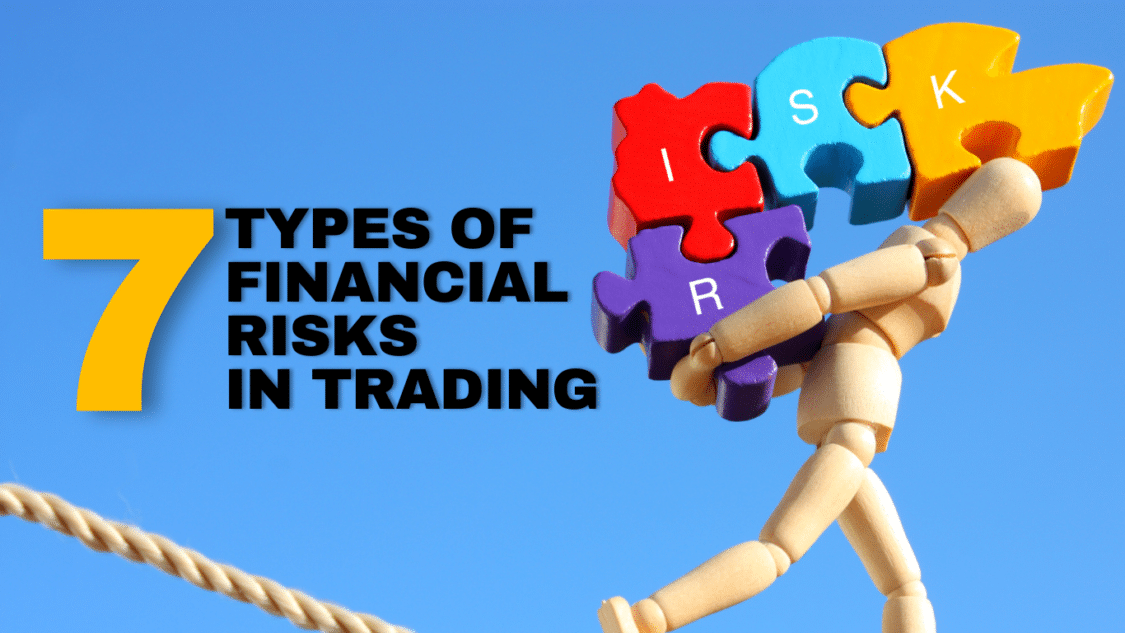Financial risks are uncertainties and potential losses from various financial transactions and activities conducted by individuals, businesses, or institutions. These trading risks can be attributed to a multitude of factors, including market conditions, economic fluctuations, regulatory environments, and internal circumstances.
In the context of trading, financial risks are specifically related to the inherent dangers associated with buying, selling, or holding financial instruments such as stocks, bonds, commodities, currencies, or derivatives. While traders aim to generate profits by capitalizing on price fluctuations in these instruments, they also incur losses due to different trading risks.

Understanding the different types of financial risks in trading is crucial for traders to manage their investments and make informed decisions effectively. In this blog article, we will explore seven common financial risks examples encountered in trading and their implications. By comprehending these risks, traders can implement appropriate risk management strategies to mitigate their impact and safeguard their investments.
Key Concepts of Financial Risks in Trading
The key concepts related to financial risks in trading revolve around understanding the nature and sources of these risks, assessing their potential impact on investments, and implementing risk management strategies to protect capital and optimize returns. This involves various tools and techniques such as diversification, hedging, position sizing, and risk monitoring.
By studying these key concepts, traders can enhance their ability to identify, analyze, and manage financial risks effectively. Moreover, staying abreast of market trends, economic indicators, and emerging risk factors enables traders to adapt their strategies and make well-informed decisions in response to changing market conditions.
In the following sections, we will explore each of these key concepts in greater detail, providing insights into their practical application and the benefits they offer in mitigating financial risks. Through a comprehensive understanding of these fundamental principles, traders can navigate the complexities of the trading landscape with confidence and resilience.
The Key Concepts:
1. Risk-Return Tradeoff: Traders typically encounter a tradeoff between risk and potential returns. Higher-risk investments often have the potential for higher returns, but they also carry a higher likelihood of losses. Conversely, lower-risk investments tend to offer lower returns. Traders must assess their risk tolerance and strike a balance between risk and reward based on their investment goals.
2. Uncertainty and Probability: Financial risks are inherently uncertain, and traders must make decisions based on probabilities and expected outcomes. They analyze historical data, market trends, and economic indicators to assess the likelihood of different scenarios and make informed trading decisions.
3. Risk Management: Risk management involves identifying, evaluating, and mitigating risks to protect investments and minimize potential losses. Traders employ risk management strategies, such as diversification, hedging, setting stop-loss orders, and implementing risk management tools like options and futures contracts.
4. Leverage and Margin: Traders often use leverage, which involves borrowing funds to amplify their trading positions. While leverage can increase potential profits, it also magnifies losses. Margin trading allows traders to enter larger positions with a minor initial capital requirement. However, it also exposes them to higher risks and the possibility of margin calls.
5. Psychological Factors: Financial risks in trading are not solely determined by external factors. Psychological factors like fear, greed, and emotional biases can influence decision-making and lead to irrational trading behaviours. Successful traders develop discipline, emotional control, and risk-aware mindsets to mitigate the impact of psychological biases.
What are the Financial Risk types in Trading?
The key financial risks traders face are Operational, liquidity, credit, market, legal, regulatory, model, and country and political risks. Each type presents its own complexities and implications, requiring careful consideration and risk management strategies.
7 Types of Financial Risk
1. Country and Political Risk: Country and political risk result from geopolitical events, government policy changes, economic instability, or social unrest. These factors can greatly impact financial markets, currency values, and investor sentiment. Traders can manage this risk by assessing relevant countries’ political and economic landscapes and diversifying their portfolios.
2. Market Risk: The concept of market risk revolves around the potential for financial losses caused by alterations in market conditions. These changes, including price fluctuations, shifts in interest rates, or geopolitical events, can impact investment values and profitability. It affects all investments and cannot be eliminated. Traders must be aware of market trends, conduct a thorough analysis, and implement risk management strategies to mitigate this financial risk.

3. Liquidity Risk: The risk of needing more market participants or depth to execute trades quickly at desired prices. This can lead to slippage and increased transaction costs. Traders should consider the liquidity of the assets they trade and have contingency plans to handle illiquid market conditions.
4. Credit risk: Arises from the possibility of a counterparty defaulting on its financial obligations. This trading risk is particularly relevant in derivative contracts, where one party may fail to meet their contractual obligations. Traders must assess the creditworthiness of their counterparties and employ financial risk management tools like collateralization and diversification.
5. Operational Risk: Stems from internal factors like inadequate systems, human errors, or procedural breakdowns. To minimize these financial risks, it is essential to prioritize trading platforms, data integrity, cybersecurity, and efficient back-office processes. Traders should establish robust risk management frameworks and comprehensive disaster recovery plans to mitigate the potential impact of such risks effectively. In contrast, systemic risk refers to the possibility of an event negatively impacting the market or industry. Employing diversification strategies can help minimize systemic risk.

6. Legal and Regulatory Risk: This occurs when changes in laws, regulations, or compliance requirements affect trading activities. Non-compliance can result in penalties, loss of licenses, or damage to reputation. Traders should stay updated on the legal and regulatory landscape, adhere to relevant rules, and maintain robust compliance measures. Compliance risk occurs when companies fail to comply with laws and regulations, leading to potential penalties or business closure. Measures like anti-money laundering (AML) and Know Your Customer (KYC) procedures are often implemented to mitigate such risks. Numerous investment firms and banks have faced lawsuits due to compliance failures.
7. Model risk: Refers to the potential inaccuracies or limitations in financial models used for trading decisions. Traders rely on various models to assess market trends, valuations, and risk exposures. However, these models may have inherent biases, assumptions, or errors. It is crucial for traders to validate and monitor their models, considering their limitations and potential of the financial trading risks.
Conclusion
Trading in financial markets presents opportunities for profit and inherent risks that demand careful understanding and management. Successful traders grasp a diverse range of risks. By applying effective risk management strategies, traders can safeguard their investments and navigate the intricacies of trading. This involves analyzing market trends, diversifying portfolios, staying updated with regulations, maintaining emotional control, practising discipline, and being risk-aware. In essence, traders need a comprehensive comprehension of financial trading risks and a diligent risk management approach to achieve long-term profitability in the dynamic world of financial markets.
Now equipped with knowledge about various financial trading risks, traders are better prepared to identify and address them. It is essential to acknowledge that trading risk cannot be entirely avoided but can be controlled and managed. The first step is gaining a solid understanding of the financial risks at play, while the second step involves implementing a robust risk management strategy to mitigate their impact. By combining risk awareness and proactive risk management, traders can strive to minimize potential losses and optimize their trading outcomes.
For more news updates, visit our homepage now and see our latest news article. Want to learn more about trading? Visit our education page now and learn for FREE!
Reasons Why Forex Traders Lose Money

